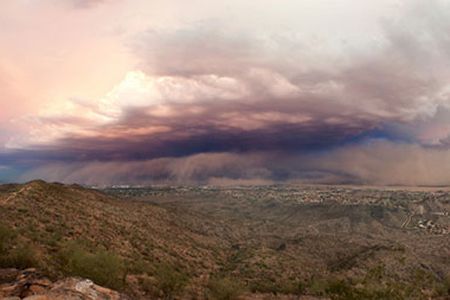Tiny Collisions Power Sandstorms

(ISNS) -- Sandstorms can sweep up millions of tons of soil and send dust whirling away for thousands of miles. Although these storms seem enormously powerful, some of their strength actually derives from the tiniest of sources: the midair collisions between individual grains of sand or dust.
When airborne particles smash into the ground during a sandstorm, they throw land-based particles into the atmosphere, like water splashing out of a lake. This process, called saltation, drives even more dirt and debris into the atmosphere. Some of those particles will fly into the air as saltons, while so-called reptons fall back down and ultimately remain earthbound.
But a new study in Physical Review Letters suggests a particle's fate depends on more than just this ground splash. A collision in midair can change an individual particle's behavior—and the motion of the storm as a whole.
To examine the effects of these collisions, an international team of researchers created a three-dimensional computer model that incorporates the behavior of individual particles during a sandstorm, giving each particle roughly the same dimensions as a grain of sand.
When the scientists told their simulation to ignore midair collisions, the flow of the storm was three times weaker than when the computer factored in the collisions. This sounds counterintuitive—you'd expect that crashing into an obstacle would shorten a particle's trajectory, not increase it. However, midair collisions can create more high-flying saltons, which drive more dirt into the storm.
"Saltons pass most of their time in the air, and because of that they gain more speed due to interaction with the wind," explained co-author Nuno Araujo of the Institute for Building Materials in Zurich. "So when they collide with the ground, they have the biggest splash."
Clearly, saltons can contribute to a storm's strength. But their creation depends on collisions with the ground, not with other airborne particles, at least according to the original model. The new study claims this picture is incorrect. To start, the reptons are actually split into two separate categories: creepers, which maintain contact with the ground, and leapers, which make small hops over the surface.
Sign up for the Live Science daily newsletter now
Get the world’s most fascinating discoveries delivered straight to your inbox.
"When saltons try to come back and touch the ground, they collide with these leapers," Araujo said. "Instead of going directly to the ground, they touch another one and another one. What we are explaining now is that saltons are created due to the history of collisions that they have in the air, not during the splash. In most cases, it's while flying that leapers will collide with other particles and become saltons."
In addition to including or excluding midair collisions in their sandstorm model, the researchers could also alter various properties of the simulated particles. This helped them find the factors that would maximize the flow of airborne debris.
The scientists discovered that a storm will be strongest when it's made up of the type of particles that lose about 30 percent of their kinetic energy in a collision. And as it turns out, grains of sand match this qualification.
Sand is the perfect material to boost a storm's strength, which explains why sandstorms can be so destructive. In addition to throwing earth about, sand and dust storms contribute to erosion, property damage, and a host of health problems from asthma to the airborne fungus that causes valley fever.
To properly prepare for these storms, and perhaps prevent dust from going airborne in the first place, scientists need to make sandstorm models as accurate as possible. "You can start looking at a model, and identify exactly where the dust-emitting places are," said William Sprigg, of the University of Arizona, Tucson.
Once researchers know the source of the dust, they can try to keep it grounded using various methods, ranging from simply banning recreational vehicles, which allows the area to develop a firm crust, to the more involved task of placing seed-filled nets, which encourages vegetation to grow and hold down the dirt.
Although incorporating the new study might add fresh information to sandstorm models, some have already proven their ability. Take the University of Arizona's Dust REgional Atmosphere Model, or DREAM, developed by Slobodan Nickovic. In July 2011, DREAM predicted the massive dust storm that engulfed Phoenix, Arizona.
As Sprigg described it, "This dust is miles high, about 30 miles deep. And our model pretty much forecast what this storm would look like almost two days in advance."
While the new information about midair collisions could aid sandstorm forecasting systems, it has other applications as well. After all, saltation doesn't just affect sandstorms, it also contributes to the motion of desert soil.
As Araujo explained, "This change in the behavior of mass transport might change what we know about the formation and evolution of the dunes."
Inside Science News Service is supported by the American Institute of Physics. Sophie Bushwick is a freelance science writer based in New York City. Her work has appeared in numerous print and online outlets.












